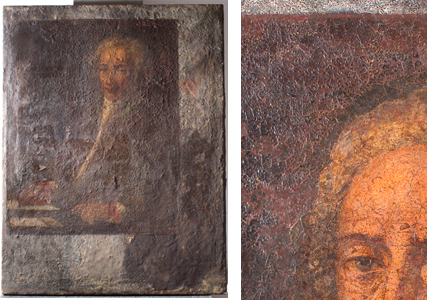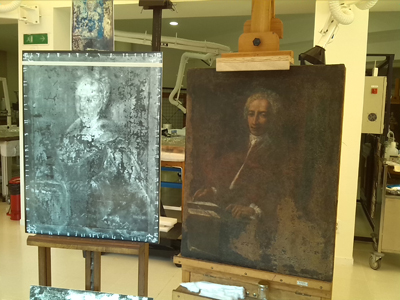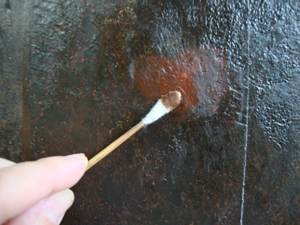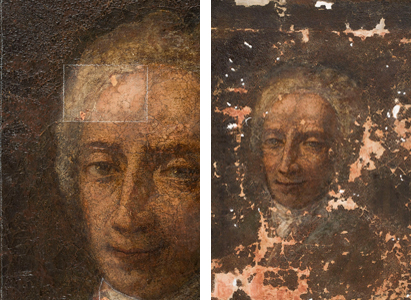On the occasion of the exhibitions based around the figure of the painter Antoni Viladomat, his Self-Portrait has been restored. His work that was in the reserves of the museum, was not exhibited due to its poor state of conservation. The painting had suffered the consequences of some unfortunate vicissitudes it had undergone in the past. In 1814, during the First Carlist War, a bonfire burned alongside other pieces, in the middle of the square of Berga. Fortunately it was saved before the flames totally destroyed it. According to Francesc Miralpeix, there is evidence that the painting was restored by a certain Mossèn Aragón and that it subsequently remained in some attics of the Hospital of Berga.
Incorporation in the Museu Nacional and state of conservation
In the register of the museum it states that on 31st August 1951, The Municipal Board agreed the purchase of the painting from Enriqueta Farriols, widow of Cabañó, for the value of 5,500 pesetas.
The work came in a frame that hid a part of the original painting. The vicissitudes that the piece had suffered, led to abundant losses of the layers of preparation and colour. At a first glance, these lacks didn’t seem evident because the work reached us with the imperfections restored: filled with plaster and mostly reintegrated. However, the plaster had not only been placed in the areas of losses, but had been spread all over the original painting, and the same criteria had been followed with the pictorial reintegration. 70% of the work had been repainted and not in a very careful way, and with a very uneven superficial layer and excessively shiny areas that contrasted with others which were very matt. Of these interventions there is no written documentation, but we can place it during the 20th century.
Due to the action of the fire, there were blisters on the pictorial layer, peculiar cracking and the original colouring that shifted towards brown tones, a characteristic feature of a painting that had been subjected to high temperatures. These features are irreversible.
The other portrait of the self-portrait: the figure of a woman
In the radiography which was done of the work so as to discriminate which parts were original and which parts were added, you can see that Antoni Viladomat had reused the canvas: underneath there appears the figure of a woman.
The artist, or one of his collaborators, covered the portrait of the woman by spreading throughout the surface of the painting a preparation of calcium carbonate mixed with clay and agglutinated with oil, brown in colour. The two paintings are so united that the losses in colour have been produced simultaneously in the two pictorial layers to the extent that the support of the canvas is left uncovered.
Process of conservation-restoration
1. Cleaning
The cleaning was slow and laborious and was carried out using mixes of dissolvent. The repainted parts, as well as the brown base (neither of them being original and done with colours mixed with varnish), were removed. An original part of the painting came to light, the other part remaining hidden by the plaster, which, selectively, was also removed, and the remains of the original painting emerged.
2. Plaster or filling in the small losses
It was decided to conserve the small parts of plaster, but it was necessary to go over the filling so as to leave it at the same level as the original painting.
3. The large lacunas: exposed canvas
The large areas of losses of the preparation layer and of the pictorial layer are, above all, located in the lower area and on the top left margin of the painting.
Here, the repainted parts have been removed as well as the plaster of the large lacunas, and the canvas has been left exposed.
4. System of presentation: pictorial reintegration
Once the cleaning of the painting was finalised, we proceeded with its varnishing. The finishing touches were started with watercolours in the areas of plaster and ended by giving thin layers of dust pigments with retouching varnish.
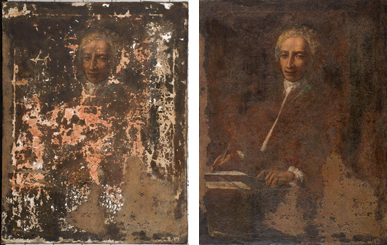
General images on the completion of the cleaning with plaster and general image after the restoration.
The restoration of the Self-Portrait began at the end of 2013 and was completed in February 2014. The work was restored by Carles Pongiluppi and Núria Prat.
The painting has been displayed in the exhibition Viladomat: The man, the artist, the work in the Museu d’Art de Girona.
Why do you think artists reuse canvases? To save money? Because of a bad review?
Related links
Preventive conservation and restoration in the Museu Nacional
Restauració i Conservació Preventiva


